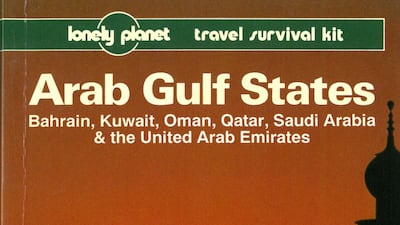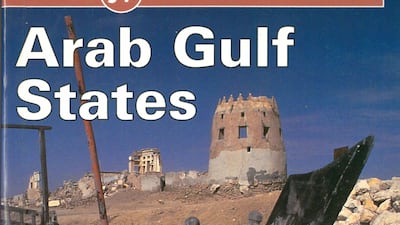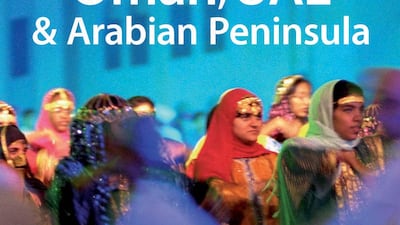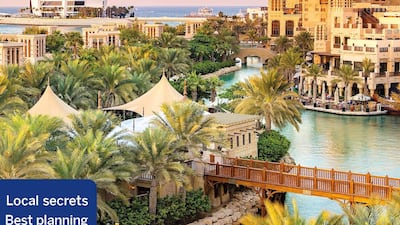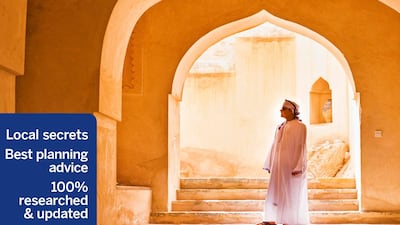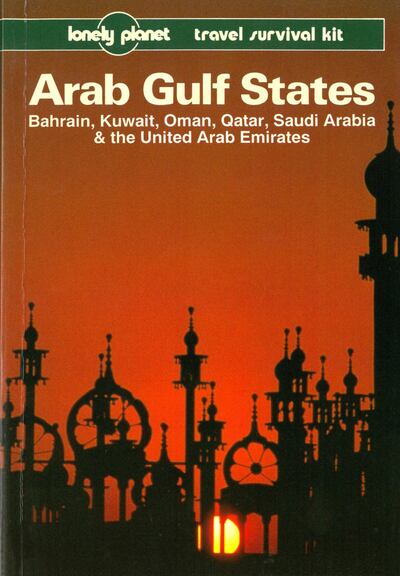“In our age of space shuttles and satellite telephones, at a time when mass tourism has penetrated even such famously remote places as Siberia and the Amazon, few regions of the world have remained as mysterious as Arabia.”
So began the introduction to the first Lonely Planet guide that featured the UAE. It was published in March 1993. By that time, the travel publisher had already been releasing guidebooks for the rest of the world for 20-plus years.
An essential companion
Lonely Planet was founded in 1972 by Maureen and Tony Wheeler, a couple of Australian free spirits who had been bitten by the travel bug. Their guides, once a symbol of counterculture, fast became an essential companion if you wanted to get under the skin of a destination. Come 2007, the company was sold to BBC Worldwide for an estimated £63 million (Dh315m) and then to an American billionaire, Brad Kelley, in 2013 for his NC2 Media venture. Now it has its headquarters in Tennessee, but retains offices all over the world, including New York, London, Australia and India, and its content is available in print, video, online and via mobile apps.
There’s still plenty of demand for their printed guides, which have undeniably become the mark of any serious traveller; a souvenir with which to line your bookshelves to remind you of travels past. And these are just as important to the destination itself, as, over the years, for a country to be featured in a Lonely Planet guide is for it to be placed firmly on the tourism map. A few snobs may still insist authentic travel can only involve an absence of flushing toilets and guaranteed gastroenteritis. But, so what?
The UAE's early tourism
In the early 1990s, the UAE, and the wider Arabian Gulf, was still far down on travellers' lists of dream holiday destinations. Visitors were mostly brought here by the oil and construction boom. It was, in some quarters, still regarded as a "hardship post". Meanwhile, books on the Emirates were largely restricted to expatriates' memoirs written by those who had witnessed its birth, or detailed excursions by the curious; people drawn to Orientalist myths of fabulously wealthy Arab oil sheikhs who tipped with Rolex watches. Some of the memoirs remain classics to this day, like Susan Hillyard's Before the Oil and Edward Henderson's autobiography Arabian Destiny. Among examples of the latter include Arabia Through the Looking Glass, published in 1979 by the British travel writer Jonathan Raban, and the truly bizarre Arabian Days, in which someone came up with the bright idea of dropping Edna O'Brien, the celebrated Irish author of Country Girls, into '70s Abu Dhabi and leaving her dazed and confused amid what was then essentially a massive construction site.
Arab Gulf States by Lonely Planet was unlike any other book that had come before it. It was a rather practical and pocket-sized guide for those wanting to experience the author's "mysterious Arabia" but also find a decent hotel, a good meal, and advice on how not to be ripped off by the airport taxi driver or the money-changer. The first edition covered all six of the Gulf Cooperation States, in alphabetical order. At the end of the book, the UAE takes up 64 of its 339 pages.
The author was Gordon Robison, an American journalist who had spent many years in the region and had lived in Cairo. “If you can only visit one country in Gulf,” he wrote, “the United Arab Emirates is probably your best choice.”
In 1990s UAE the first inklings of mass tourism could be seen. Emirates Airline had been founded eight years earlier, sparking the transformation of Dubai into an international aviation hub that would eventually bring in more than a billion passengers. When Arab Gulf States was first published, the UAE was already welcoming 100,000 visitors a year, thanks in part to its excellent infrastructure and relative ease of entry – plus the first winter sun packages were being offered by European travel companies.
A window into the past
Looking back, however, is an exercise in nostalgia. Out-of-date travel books are like time machines. They transport you back to their present, for which they were intended. They are rooted in the now, and are not written for our future selves.
The first book's cover featured a sunset behind the fantastic minarets of the Al Fahim mosque that once stood on Airport Road near the Abu Dhabi Corniche. Priced at US$15.95 or £9.95 (now the equivalent of Dh73.2), Arab Gulf States offered useful tips such as getting a hotel to sponsor your visa. "Be sure to get the hotel to fax you back a copy of the visa when it is ready or the airline may not let you travel," it warned. Cheaper hotels, it suggested, could be found for Dh60 around the Dubai souqs, or up to Dh700 for the fanciest places like the Sheraton Dubai Creek, which opened in 1978. Abu Dhabi, it added, tended to be a bit cheaper.
Much of the advice still holds good today. Such as dress modestly in public places or watch out for dangerous drivers. Long-term residents would smile at the advice for getting around the capital: “A lot of people who have lived in Abu Dhabi for a long time, haven’t the foggiest idea of what the streets are called – officially and unofficially!”

It singled out just three places to see in the capital: The Cultural Foundation, Qasr Al Hosn and a women's craft centre. "Abu Dhabi is probably not as boring as its reputation, but it does not have Dubai's energy or its nightclub scene," the guide concluded sniffily. All this just goes to show how the evolution of the Lonely Planet in the UAE reflects the country's startling growth as a travel destination.
It was three years before the second edition of Arab Gulf States was published, in October 1996. In 2004 it became Arabian Peninsula. According to its author, the UAE was now "a contradictory place where traditional Bedouin customs and lifestyle meet western consumerism and big-town sophistication". Then, Oman and the United Arab Emirates arrived in print in 2000. That merged with the 2007 edition to create Oman, UAE and the Arabian Peninsula. A sixth edition of this guide is due out this September.
However, the turn of the millennium also saw the UAE get its very own Lonely Planet guide, called Dubai & Abu Dhabi. It covered the whole country but had a heavier emphasis on Dubai. The latest edition of this guide – the ninth – came out last December. On top of this, there are two pocket guides: one each for Abu Dhabi and Dubai. Pocket Dubai was first published in October 2007, initially as an Encounter guide, and its latest edition came out last year. Pocket Abu Dhabi was first published last September, a clear sign of the emirate's growth as a destination in its own right, with the second edition due in September. Overall, seven separate Lonely Planet titles have covered the UAE over the years.

A growing interest in the UAE
Lauren Keith, Lonely Planet’s destination editor for the Middle East and North Africa, says the growth of titles from one to four over 25 years reflects “the growth in interest of the UAE as a tourist destination”.
“Keeping our content up-to-date is a huge challenge, as there is so much happening and the country is constantly evolving,” she adds. “It's especially busy in the run up to big events such as Expo 2020 in Dubai, with so many new places being built and opening.”
To make sure all of the content stays fresh, the company relies on contributors based here. For every new edition, two or three experienced writers will be involved in the compilation process. These are people “who have their ears on the ground to provide us with the latest info”, she explains. Importantly, they want advice that will work for their specific audience, which hasn’t changed much over the years. “[Our readers] often want to know what the budget options are or which once-in-a-lifetime experiences are worth the high ticket price, especially for the UAE which is often billed as a destination that will break the bank.” It might seem ironic, then, that the cover of the current edition features a photograph of the Burj Al Arab hotel, where the nightly room rate is typically around Dh7,000.
What may have seemed “mysterious” in 1993 has perhaps only gotten more intricate over the years. Now it’s much, much more than just a place to find oil; it’s a destination for luxury, culture, food, adventure sports – you name it. The more tourists flock here, the more there is to see, and now, as the current guide puts it, Abu Dhabi and Dubai are “fertile environments conductive to breaking down cultural barriers and preconceptions”.
